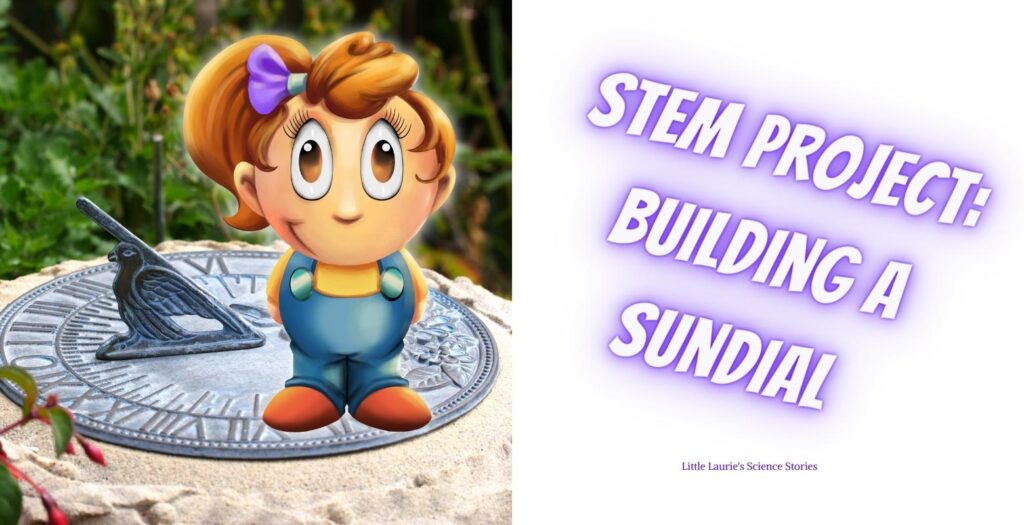Building a Sundial
Sundials are some of the oldest timekeeping devices in the world. Sundials work by using the sun’s position in the sky to tell time and building one can be a fun and educational STEM activity for elementary school-aged children.
Sundials have been used for thousands of years, with evidence of their use dating back to ancient Egypt and Babylon. They were particularly popular during the Renaissance era, and many beautiful sundials can still be seen today in parks, gardens, and public spaces worldwide.
Not only are sundials a fun way to learn about history and culture, but they also provide a great opportunity for kids to learn about science and engineering. Building a sundial requires an understanding of geometry, as well as some basic principles of physics and astronomy. Plus, it’s a hands-on project that encourages kids to experiment, problem-solve, and think creatively.
In this article, we’ll show you how to make a simple sundial using a paper plate and other common materials. We’ll also discuss some of the science behind sundials and why they work. By the end of this article, you and your kids will have a basic understanding of how sundials work and be able to build your own working sundial at home!
Before we get started, let’s talk a bit more about the science behind sundials. As you may know, the Earth rotates on its axis, causing the sun to appear to move across the sky during the day. This apparent movement is what makes a sundial work; by measuring the position of the sun in the sky, we can tell what time it is.
To understand how a sundial works, it’s important to know that the Earth’s axis is tilted at an angle of about 23.5 degrees relative to its orbit around the sun. This means that the angle at which sunlight hits the Earth’s surface changes depending on the time of year and the latitude of the observer. We’ll talk more about this later as we learn how to use the sundial.
The basic principle behind a sundial is that a vertical object, called a gnomon, casts a shadow on a flat surface, called a dial plate. As the sun moves across the sky, the position of the shadow changes, allowing us to tell time.
Now that we’ve covered the basics of sundials let’s move on to building one! To make a simple sundial out of a paper plate, you’ll need the following materials:
- A paper plate
- A pencil, straw, r similar object
- Markers, paint, or crayons to decorate.
In the next section, we’ll go through the step-by-step process of building your own working sundial with these materials.
Sundial Construction
Building a paper plate sundial is a simple and fun STEM project that children can do at home or in the classroom. To get started, you’ll need a paper plate, paint or markers, a ruler, scissors, a pencil, and a straw. Here are the steps to create your own sundial:
-
- Paint the back of the plate or leave it plain. This will serve as the dial plate for your sundial. You can use any colors you like, but it’s best to use a light color so that the numbers and shadows are easier to see.
- Draw a clock face on the back of the plate. Using a ruler and a pencil, draw a circle in the center of the plate, leaving a border of about 1-2 inches around the edge. Then, divide the circle into 12 equal segments and label them with the hours of the day.
- Punch a hole in the center. Using a pair of scissors or a hole punch, make a small hole in the center of the plate. This is where you will insert the gnomon, or the object that casts the shadow.
- Stick a pencil through the hole—then head outdoors! Take your sundial outside and find a sunny spot with a clear view of the sky. Place the plate on a flat surface, and make sure the straw is straight and upright, and that it casts a clear shadow on the dial plate. The shadow will move throughout the day as the sun changes position in the sky, allowing you to tell time based on the position of the shadow.

Telling Time With a Sundial
Using a paper plate sundial to tell time is easy and fun! Once you’ve built your sundial, find a sunny spot outside and place your sundial on a flat surface that gets plenty of sunshine. Make sure the 12 on your clock face is pointed north. This will ensure that the shadow moves in the correct direction as the sun moves across the sky.
As the sun moves across the sky, the shadow will move across the clock face, indicating the time. It’s important to remember that the time on your sundial may not always match the time on a traditional clock, as it doesn’t account for daylight saving time or time zone differences. However, using a paper plate sundial is a great way to learn about the relationship between the sun and shadows, and to explore the science behind telling time. So give it a try with your kids and have fun learning together!
Bonus experiment: If you go out and check the clock at the same time every day, mark off how long the shadow is. You will see the shadow lengthen and shorten from one day to the next, just as it does during the day!
Sundial Trivia
- Did you know that the term “clockwise” comes from the motion seen on a sundial in the northern hemisphere? As the shadow moves across the dial plate, it appears to move in a clockwise direction.
- One famous sundial is the Great Sundial at the Jantar Mantar observatory in Jaipur, India. This massive sundial is over 27 meters tall and is accurate to within 2 seconds! It was built in the early 18th century by Maharaja Jai Singh II and is one of the largest sundials in the world.
- To use a sundial accurately, it’s important to adjust the angle of the gnomon based on your location. This is because the angle at which sunlight hits the Earth’s surface changes depending on your latitude and the time of year.
- The oldest known sundial is believed to have been found in Egypt and dates back to around 1500 BCE.
- The first portable sundial was invented by the ancient Greeks and was known as the hemispherium.
- Sundials were once used to help calculate longitude, which led to the development of the marine chronometer in the 18th century.
- Sundials can be used to determine the time of year as well as the time of day, by tracking the movement of the shadow over a period of time.
NGSS Standards
The sundial project is an excellent complement to learning about telling time and shadows. It aligns with the Next Generation Science Standards (NGSS) MS-ESS1-1 and 1-ESS1-2, which focus on the Earth’s place in the universe and the interactions between the Earth, sun, and moon. By building a sundial, children can learn about the relationship between the position of the sun in the sky and the time of day, as well as how shadows change throughout the day. This hands-on project can help kids develop critical thinking skills and an interest in science and engineering.
Little Laurie Can Help!
Does your child have questions? The next volume to Little Laurie’s Science Stories can help! In this upcoming book, Little Laurie learns about her shadow and why it keeps changing its size. Keep your eyes out for the next Little Laurie Story, coming soon to Amazon!
In the meantime, you can start your child’s journey into the science of time and how the Sun and Earth work together by picking up a copy of “The Day the Sun Forgot to Wake”.



